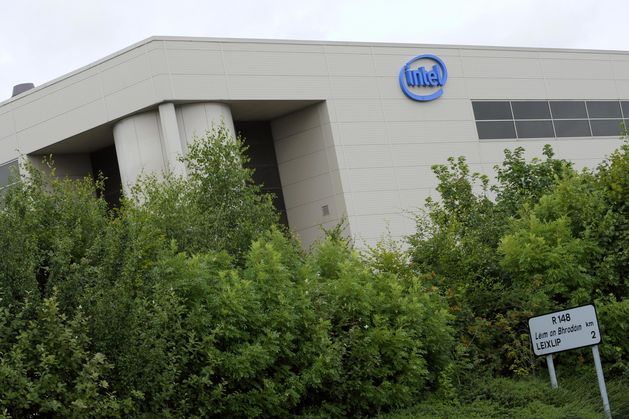
Second-quarter revenue will be between $11.2 billion and $12.4 billion, the company said in a statement on Thursday.
That was well short of the $12.9 billion average analyst estimate, sending the shares down more than 6pc in late trading.
The cost-cutting plan will involve “eliminating management layers” to enable it to make faster decisions, Intel said.
The company doesn’t yet have an estimate for the one-time expenses associated with the cuts, but expects operating costs to be reduced to about $17 billion this year and $16 billion in 2026.
Bloomberg News reported this week that Intel is planning to slash its employee ranks by more than 20pc.
Intel’s earnings report is the first under the leadership of Tan, a chip industry veteran who took the job last month.
The board hired him after predecessor Pat Gelsinger struggled to restore the competitiveness of Intel’s products. He was ousted late last year after sliding sales and mounting red ink doomed his comeback bid.
A bright spot for Intel – first-quarter sales came in at $12.7 billion, topping predictions.
The chipmaker follows Texas Instruments Inc. in delivering stronger results than analysts had projected.
But its weak forecast suggests that the the uptick in demand was just a blip driven at least in part by a rush of orders ahead of looming tariffs being threatened by the US, China and others.
“The current macro environment is creating elevated uncertainty across the industry, which is reflected in our outlook,” Intel Chief Financial Officer David Zinsner said in the statement.
“We are taking a disciplined and prudent approach to support continued investment in our core products and foundry businesses while maximizing operational cost savings and capital efficiency.”
Zinsner said he doesn’t currently have an estimate for the size of the workforce reduction.
Thursday’s conference call will be the first time Tan has faced questions from Wall Street on how he plans to resurrect the company’s fortunes, something he’s said “won’t happen overnight”.
Gelsinger had concentrated on Intel’s factory network, once its most powerful asset. He laid out plans to spend tens of billions of dollars on giving the company the world’s best production technology again, and luring rivals into using it as outsourced provider of manufacturing.
“The first quarter was a step in the right direction, but there are no quick fixes as we work to get back on a path to gaining market share and driving sustainable growth,” Tan said in the statement.
“I am taking swift actions to drive better execution and operational efficiency while empowering our engineers to create great products. We are going back to basics by listening to our customers and making the changes needed to build the new Intel.”
Beyond its cost problems, the company missed out on one of the biggest bonanzas in the semiconductor industry’s history: the explosion of artificial intelligence computing.
Nvidia Corp.’s dominance in that area has allowed it to far surpass Intel in revenue and market valuation.
Intel shares, after several years of being shunned by investors, have performed relatively well in 2025, eking out a 7.2pc gain. The Philadelphia Stock Exchange Semiconductor Index, in contrast, has fallen almost 16pc.
In the first quarter, the company had a loss of 19 cents a share. Analysts estimated a loss of 22 cents a share on sales of $12.31 billion.
Last year, Intel’s annual revenue was down about $26 billion from its peak in 2021. It’s now less than half the size of Nvidia by that measure, and analysts aren’t predicting a rapid rebound anytime soon.
Intel’s CFO said the company shares Wall Street’s concern that a good start to the year might not reflect underlying demand and may have been helped by stocking up ahead of tariffs.
“That probably pulled some demand we would have seen beyond the first quarter into the first quarter and softened up the second quarter,” he said.
Looking ahead, the company is concerned that consumer spending and investment in areas such as data centre infrastructure may decline.
Uncertainty about tariffs is making the environment harder to predict and prompted Intel to offer a wider range of sales forecasts.
Intel is focused on improving its balance sheet and is cutting the budget for new plants and equipment by a further $2 billion, Zinsner said. Under Tan’s leadership, the chipmaker will look to focus on a small number of areas and sell off units that aren’t related to those efforts.
The new round of job cuts, following a roughly 15,000 reduction last year, may bring it more in line with that new scale and what competitors are achieving with fewer workers.
Nvidia has about a third of Intel’s staff, and manufacturing leader Taiwan Semiconductor Manufacturing Co. gets double Intel’s revenue with about 30,000 fewer people on its payroll.
Intel’s adjusted gross margin, the percentage of sales remaining after excluding the cost of production, was 39.2pc in the first quarter and will be 36.5pc in the current period.
At its peak, Intel regularly reported gross margin of well above 60pc. Nvidia’s is above 70pc.
Sales at Intel’s foundry business, a unit that makes chips for outside customers, rose 7.1pc to $4.67 billion. That topped the estimate of $4.3 billion.
Personal computer chip sales were $7.63 billion, down 7.8pc. Analysts had projected $6.93 billion. Intel’s data center and AI chip unit had sales of $4.13 billion.
#Intel #delivers #disappointing #forecast #ahead #job #cuts #bring #costs #line #smaller #size







